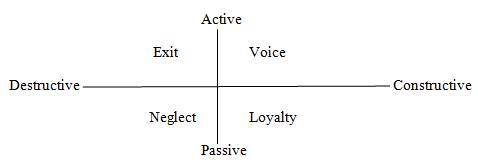Employee can express job dissatisfaction in a number of ways. For example, rather than quit, employees can complain, be insubordinate, steal organizational property, or shirk a part of their work responsibilities. Following figure offers four responses to job dissatisfaction that differ from one another along two dimensions: constructive/destructive and active/passive.
They are defined as follows:
- Exit: Behavior directed toward leaving the organization, including looking for a new position as well as resigning.
- Voice: Actively and constructively attempting to improve conditions, including suggesting improvements, discussing problems with superiors, and some forms of union activity.
- Loyalty: Passively but optimistically waiting for conditions to improve, including speaking up for the organization in the face of external criticism and trusting the organization and its management to “do the right thing”.
- Neglect: Passively allowing conditions to worsen, including chronic absenteeism or lateness, reduced effort, and increased error rate.
Exit and neglect behaviors encompass our performance variables-productivity, absenteeism, and turnover. But this model expands employee response to include voice and loyalty-constructive behaviors that allow individuals to tolerate unpleasant situations or to revive satisfactory working conditions. It helps us to understand situations, such as those sometimes found among unionized workers, for whom low job satisfaction is coupled with low turnover. Union members often express dissatisfaction through the grievance procedure or through formal contract negations. These voice mechanisms allow union members to continue in their jobs while convincing themselves that they are acting to improve the situation.
